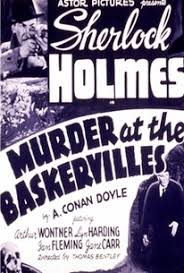
It’s been twenty years since Sherlock Holmes (Arthur Wontner) tangled with the hound of the Baskervilles. Several times Sir Henry (Lawrence Grossmith) has asked Sherlock to visit. On this occasion Sherlock and Dr. Watson (Ian Fleming) take him up on his offer. A vacation of sorts. Inspector Lestrade (John Turnbull) is also in Exeter. He is on a temporary assignment due to the anticipated Barchester Cup horse race requiring additional security. Also in the area is Professor Moriarty (Lyn Harding). The horse race means money and Moriarty likes money.
One of the horses to compete in the race is a horse named Silver Blaze. At the time the horse was first entered his odds were somewhere around 106 to 1. Since then he has come up first in all his trials. Now favored to win, the bookies are over extended and are in the real position of possibly going out of business. This is where Moriarty’s expertise comes in.
Suffice it to say that the morning of the last trial Silver Blaze is missing and the night watchman is found dead. Enter Sherlock Holmes. While tracing the steps the thief made with Silver Blaze Holmes and company come upon the body of James Straker (Martin Walker) the stable manager.
“Murder at the Baskervilles” AKA “Silver Blaze” was released in 1937 in Britain and 1942 in the US. The film was directed by Thomas Bentley. It is a British, black-and-white crime and mystery film, based loosely on Arthur Conan Doyle's short story "Silver Blaze". The title was changed to “Murder at the Baskervilles” for the US release to capitalize on the whole Baskerville theme. Basil Rathbone’s portrayal of Holmes in “The Hound of the Baskervilles” was released in 1939.
It is the fifth and final screen appearance by Arthur Wontner as Sherlock Holmes, and the fourth and final film for Ian Fleming as Dr. Watson. The five films that Wontner play Holmes in were “Sherlock Holmes' Fatal Hour” 1931 "The Missing Rembrandt" 1932, “The Sign of the Four” 1932, "The Triumph of Sherlock Holmes" 1935, and "Silver Blaze" 1937.
“Sherlock Holmes and the Missing Rembrandt” 1932 is considered a lost film. "Sherlock Holmes' Fatal Hour" 1931 was also considered a lost film for decades until a print was discovered in the United States.
Wontner’s portrayal of Holmes is considered by many Holmes aficionados as the definitive Sherlock Holmes, even over Rathbone. Since then there have been a plethora of Holmes portrayers, everyone from Benedict Cumberbatch to Johnny Lee Miller, so in my opinion, the best Sherlock Holmes is the one you like the best. Even if you have a favorite, there is no reason why you can’t appreciate someone else’s technique.
As for the movie itself, I felt it was a little slow. Granted it was only an hour and five minutes long but the story itself didn’t seem all that long, or mysterious. It was pretty obvious up front that whatever happened and whoever the killer was, Moriarty was responsible even though the Moriarty character had a small part in the film. There were a couple interesting tidbits but they were explained out of hand and went by so fast that they seemed a little anticlimactic. The movie was OK. I just wasn’t in love with it.

